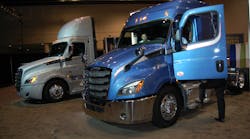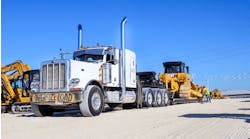ORLANDO. Truck production is expected to “finish strong” this year, with “no pause at all” in commercial vehicle orders, according to Roger Nielsen, president and CEO of Daimler Trucks North America (DTNA).
In a round-table interview with reporters here at the 2017 American Trucking Associations (ATA) Management Conference & Exhibition (MC&E), Nielsen added that there are “no plans” at the moment to increase sticker prices on DTNA’s models, though he explained that there is “definitely pressure” as the rising costs of raw materials “is an area of discussion.”
“Our plan is to remain focused on fuel efficiency and safety; that’s everything in trucking,” Nielsen said.
While he didn’t provide specific numbers, he added that year-to-date (YTD) truck sales are up for DTNA versus the same point in 2016. Freightliner Business Class medium-duty model and severe-duty model sales are up 9% and 16% versus last year, while Western Star sales are up 30%. Meanwhile, sales of Freightliner Custom Chassis Corp. (FCCC) and Thomas Built Buses (TBB) among other specialty” models are up 9% as a group.Though sales of “premium” linehaul tractors are off 1% versus last year, overall, DTNA’s total YTD truck sales for the NAFTA region is up 6% versus 2016.
Nielsen commented on a wide range of issues during his meeting with reporters, touching on everything from truck platooning to autonomous driving and electrification:
• He views the company’s Detroit Connect Virtual Technician remote diagnostic system as “more and more of an advantage” in the trucking market in terms of reducing downtime for repairs. “It is all about uptime in this market now,” Nielsen noted.
• He said everything DTNA is doing in terms of developing platooning and autonomous technology is “aimed at safety; that’s what we are putting our money on – everything we can do to make the driver’s life safer and help them complete their mission,” in part because “we don’t believe trucks will be completely driverless in the future.”
• In terms of truck platooning research “there is technically no limit” as to how many tractor-trailers one can “synch together.” However, “we are still searching or applications that make sense for two-truck platoons; we’ve not seen anyone yet asking for five-truck platooning applications.”
• Nielsen noted that DTNA now refers to itself as “a mobile device company that happens to build trucks and buses” because today’s trucks and buses are becoming like iPhones; the technological “base” for different applications.
• “It doesn’t make sense for a customer to have 18 different [communication] contracts for cameras, braking systems, telematics, and other technologies,” he explained. “Our capacity, our ‘box,’ can provide a single electronics and communication platform. Apple for example does not write every software application for its iPhone; it acts as a host for them.”
• While DTNA is watching fuel economy and greenhouse gas (GHG) regulation rollback discussions closely, “regardless of what happens, we’ve moved on with our business plans,” Nielsen said.
• A major concern with autonomous vehicle technology is the “shifting of liability” when it comes to crashes and managing traffic congestion, he said; issues still being debated.
• Are electric trucks viable? Nielsen noted that DTNA plans a “full launch” of the eCanter all-electric medium-duty truck built by its Mitsubishi Fuso division in Japan, the U.S., and European Union nations in 2019 with four models, followed by “more models in multiple classes” in 2020 and beyond.
• “We believe we still need more power density from the batteries and lower total cost of operation (TCO),” he said. “We’re working with fleets right now to define different use cases.”
DTNA also made several product announcements during the annual ATA MC&E.
First the company is offering a series of upgrades to the Freightliner Cascadia family of heavy-trucks, including:
• Keyless entry that that not only offers buttons for locking and unlocking the doors but that also rolls down windows and tests the bulbs on the truck’s exterior lights prior to driving the vehicle. Each truck purchase includes two keyless entry transmitters that are paired at the plant, with one transmitter capable of being paired to multiple trucks.
• A new built-in power supply for medical devices, powered by an absorbent glass mat (AGM) battery mounted under the bunk and vented externally that offers eight to 10 hours of power for equipment such as a Continuous Positive Airway Pressure (CPAP) device for drivers with sleep apnea.
DTNA is also making its new Detroit Connect mobile application available for download for Freightliner and Western Star customers who have an active Detroit Connect subscription, which allows them to access information about their vehicles’ performance without needing to be at a desk or on a computer.
The new app, available for iOS or Android-enabled mobile devices, is available for free in Apple’s App Store or Google Play, DTNA said, with access to the new Detroit Connect portal and mobile app included with any active Detroit Connect subscription at no charge.
Finally, the OEM noted that its Detroit Connect Virtual Technician remote diagnostic system can now deliver remote fault event diagnostics for Detroit DT12 automated manual transmissions (AMT) – monitoring up to 150 distinct faults for that gearbox.
The Virtual Technician diagnostic process for the DT12 is similar to the process for Detroit engine and after-treatment systems, DTNA said, with fault events “categorized” based on how severe vehicle drivability is affected.
“Since we launched Virtual Technician in 2011, we have been improving it by integrating additional Detroit components,” said Kary Schaefer, general manager, marketing and strategy, Daimler Trucks North America. “We pride ourselves on helping customers understand their truck’s health and maximizing the uptime.”




